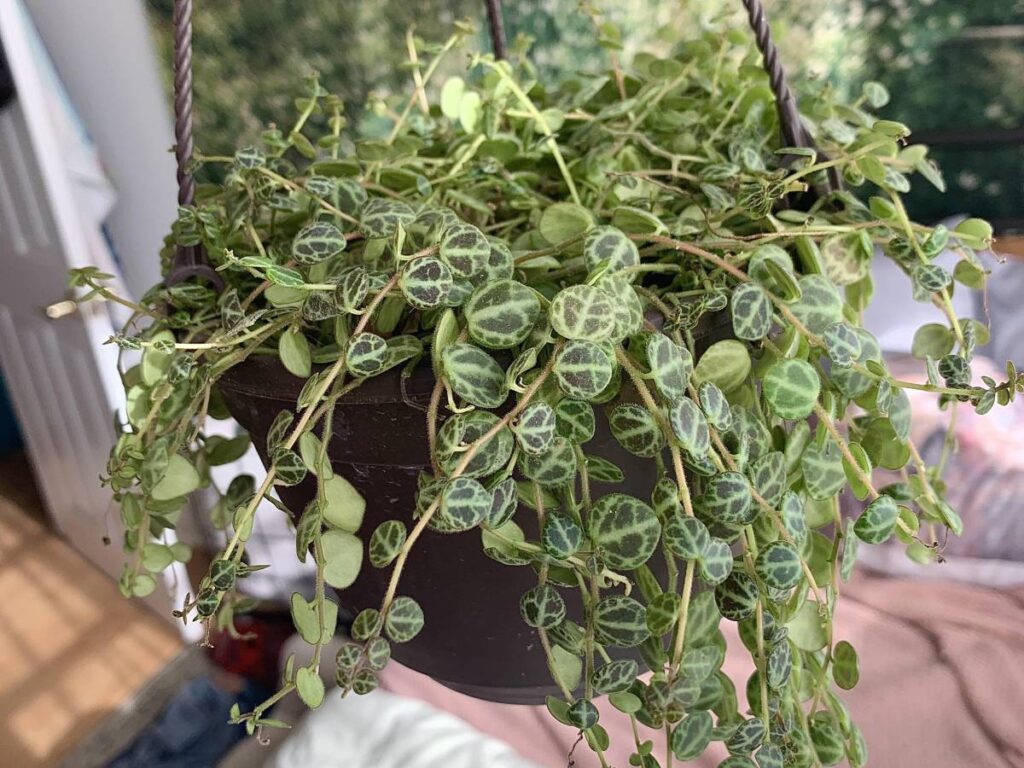Are you looking to add more string of turtles plants (Peperomia Prostrata) to your collection? Propagation is a simple and affordable way to do so.
In this guide, we’ll walk you through the steps for successfully propagating a string of turtles.
All you need are a few basic tools and a little patience. Let’s get started
Is the String of Turtles Plant Easy to Propagate?
It is easy to propagate. All you need to do is cut a stem from the mother plant, remove the leaves from the bottom half, and place it in moist soil in indirect sunlight. Once roots have grown, transfer the stem to a pot with fresh soil and water regularly.

Step-by-step Instructions for Propagating String of Turtles
Are you ready to start propagating your own string of turtles plants? Follow these easy steps to create new, healthy plants in no time!
1. Select the string of turtles you want to propagate
When propagating a string of turtles plant, it’s essential to select a healthy and mature specimen. You should avoid plants that are diseased or have broken stems, as these issues may be passed on to the new plants.
Look for a plant that has plenty of nodes, as these are the areas where new growth occurs and are the best places to take cuttings.
Once you’ve chosen a healthy string of turtles, you’re all set to start the propagation process!
2. Gather the necessary materials
Before you begin the propagation process, you need to gather all of the necessary materials. You will need:
- Scissors: Use sterilized scissors to take a cutting from the mother plant.
- Rooting hormone: This can help encourage root growth in the cutting.
- Pots or containers: These will be used to house the cuttings while they root.
- Soil mix: A well-draining soil mix is best for propagating Peperomia Prostrata.
Make sure to have all of these materials on hand before you begin the process to ensure smooth and successful propagation. To stop the spread of diseases or infections, it’s important to use scissors that have been cleaned and sanitized.
3. Identify the “nodes” on the string of turtles where new plants can be propagated
The “nodes” on a string of turtles are the points where leaves join the stem. These are where new roots will emerge when you make a cut behind them.
They are indicated by small bumps or ridges on the stem and can be seen in this photo:

4. Cut the stem at a node using sterilized scissors
Now it’s time to take your cuttings! Using sterilized scissors, carefully cut the stem at a node.
To take the cutting:
- Grasp the stem firmly with your non-dominant hand.
- Position the sterilized scissors at the node you identified.
- Gently but firmly press the scissors through the stem to make a clean cut.
Remember, the healthier the mother plant, the more likely the cuttings will be to grow into strong, healthy plants. So be sure to choose a mature, healthy plant and use sterilized scissors to take your cuttings.
5. Dip the cut end in rooting hormone
It’s time to apply rooting hormone to the cut end of the stem. Rooting hormone is a powder or liquid that contains growth hormones that promote root growth in cuttings. Rooting hormone isn’t necessary, but it can help plants take hold and grow roots.
To apply the rooting hormone:
- Pour a small amount of rooting hormone into a shallow dish.
- Dip the cut end of the stem into the rooting hormone, making sure to coat it thoroughly.
- Tap the stem gently to remove any excess rooting hormone.
That’s it! Your cuttings are now ready for soil planting.
6. Place the stem in a pot or container filled with moist soil
Now it’s time to plant your cuttings! Fill a pot or container with soil that drains well and give it a little water. Then, gently press the cut end of the stem into the soil, making sure it is fully supported.
You can plant multiple cuttings in the same pot or container; just be sure to space them out and give them enough room to grow.
To plant the cuttings:
- Fill a pot or container with moist soil mix.
- Gently press the cut end of the stem into the soil, making sure it is fully supported.
- Repeat this process for each cutting you are planting.
Now we are ready for the next step in the propagation process.
7. Cover the pot or container with a plastic bag to create a greenhouse effect
One simple way to ensure they have the best chance to root and grow is by creating a humid environment. This can be done by covering the container or pot with a plastic bag to create a greenhouse effect.
To do this, place the container on a flat surface, and then drape the plastic bag overtop, making sure it fully covers the pot or container. Then use either a rubber band or tape to secure the bag in place.
With this method, your cuttings will be protected from drying out so that they can take root properly and grow into healthy plants.
8. Place the pot or container in a warm, well-lit location
The next step is placing the cuttings in a warm, well-lit location. This will help ensure that your cuttings receive the optimal amount of light and warmth they need to grow into healthy plants.
Choose a spot that receives bright, indirect light and avoid direct sunlight, as this can scorch your plants and cause them to dry out.
Additionally, find a location that is warm and free of drafts to keep the environment balanced.
9. Monitor the progress of the new plants and adjust watering as needed
As your cuttings grow and develop roots, you may notice new growth appearing on the stems. This is a good sign that your cuttings are rooting and growing into healthy plants.
Keep an eye on how your cuttings are doing and make changes to the watering as needed to keep the soil evenly moist.
It’s also a good idea to check the cuttings regularly for any signs of disease or pests.
If you notice any problems, take steps to address them immediately to help ensure the health of your new plants.
What Is the Best Way to Propagate a String of Turtles?
There are several ways to propagate a string of turtles, including:
Taking stem cuttings and putting them in soil to grow roots is the most common and effective way to make more turtles.
Propagating string of turtles in water: While it is possible to propagate string of turtles plants in water, this method is not as successful as rooting cuttings in soil.
Leaf cuttings propagation: This is a method of plant propagation that involves rooting plant leaves in soil to produce new plants. Most of the time, this method is used to grow plants that don’t have stem cuttings or seeds, or that are hard to grow using other methods.
Propagating a string of turtles from seeds: Although it is less common, it is possible to propagate a string of turtles from seeds.
The best way to propagate string of turtles is to take stem cuttings and root them in soil (this is the method I have shown above). This method is relatively easy, affordable, and has a high success rate.

How to propagate string of turtles plant in water?
If you’re looking for an easy and rewarding way to propagate string of turtles plants, then propagating them in water may be the ideal method for you. All you need are a few materials: sterilized scissors and a container or jar of water, and you’ll be ready to go! Here’s how it works:
First, use your sterilized scissors to cut off a few stem cuttings just below a node. Then, put the bottom end of the cutting into the jar or other water-filled container, making sure that at least one node is submerged. You’ll also want to remove any leaves that end up being left beneath the surface.
Place the container in direct sunlight and change the water once a week or as needed. When the roots start growing out (which should take a few months), transfer them over into soil-filled pots and care for them like a regular houseplant.
How do you propagate a string of turtles from leaf cuttings?
Propagating string of turtles from leaf cuttings is an easy process that requires just a few materials. You’ll need scissors, rooting hormone, pots or containers, and soil mix. After gathering these supplies, follow these steps to propagate your own string of turtles plant:
First, carefully remove a healthy leaf from the stem of the mother plant. Make sure to keep as much of the leaf intact as possible so it can grow into a new plant.
Once removed, allow the leaf to sit for several days in indirect sunlight or away from direct sunlight so that it can begin the callousing process.
From here, take your prepared leaf and place it in well-draining potting soil. Gently press the leaf into the soil and lightly water it until moist but not wet.
Place your pot or container with the freshly potted leaf cutting in an area with indirect light and wait for roots to form over a period of several weeks.
Once the roots of your new plant are well-established, you can move it to a bigger pot or garden space to help it grow.
What Are the Benefits of Propagating String of Turtles?
Did you know that propagating Peperomia Prostrata can not only save you money but also bring a sense of accomplishment and joy to your gardening experience? Here are just a few benefits of propagating string of turtles plants:
1. It is a cheap way to increase the number of plants
Propagating string of turtles helps increase the number of plants because they have shallow roots and do not require to be repotted. By propagating the plant, you can create new plants that can be planted in your home or given as gifts.
2. It is an easy process
It is relatively easy due to the plant’s ability to root easily from stem cuttings, its low maintenance needs, and its tolerance for mistakes.
All that is needed is scissors, rooting hormone, soil or water, and a pot or container. These plants are also forgiving, so any mistakes made during the propagation process will not necessarily kill the plant.
3. It increases the diversity of the plant collection
Propagating Peperomia Prostrata increases the diversity of a plant collection because it allows gardeners to reproduce the plant and increase its population.
By making new plants, gardeners can add to their collection of plants and enjoy their beauty for years to come.
Also, if this species’ population grows, more people will be able to see and experience its unique qualities for themselves.
4. It allows you to adapt the needs of each plant
When you propagate your own plants, you have control over the conditions under which the plant is grown, such as the type of soil, light levels, and watering frequency.
This can be especially useful if you have plants with different care needs or if you want to experiment with different growing conditions to see what works best for a particular plant.
By propagating your own string of turtles plants, you can also ensure that each plant is given the attention and care it needs to thrive.
For example, if you have a plant that is struggling in its current location, you can propagate a cutting and try it in a different location to see if it performs better.
5. It increases the chances of survival for the new plants
Propagation of string of turtles can significantly increase the chances of survival for the new plants by allowing them to grow in large quantities.
By propagating a string of turtles, you can make sure that you have a lot of healthy plants to sell or plant elsewhere. This makes it easier for people to get to these beautiful and useful plants, which increases their chances of surviving.
6. It improves the quality and vigor of the new plants
When you propagate your own plants, you can choose healthy, vigorous cuttings to use as the starting point for your new plants. This ensures that the new plants have a strong foundation and are more likely to grow into healthy, robust plants.
In addition, propagating Peperomia Prostrata allows you to control the conditions in which the new plants are grown, such as the type of soil, light levels, and watering frequency. This can help the new plants grow and develop in the best way possible, giving them more quality and strength.
7. It gives you the opportunity to try different varieties
Because they can be propagated by cutting off pieces of the mother plant and replanting them in soil, the string of turtles allows you to try different varieties. This allows you to experiment with different types of string of turtle plants without having to purchase new ones each time.
In contrast, other types of houseplants, such as air plants cannot be propagated through cutting and must be purchased anew each time you want another one.
8. It allows you to experiment with different growing mediums and conditions
Propagating string of turtles allows you to experiment with different growing mediums and conditions because it is an easy plant to grow.
You can use a variety of materials as a growing medium, such as soil, pebbles, sand, or even water. You also have control over the amount of sunlight, water, and fertilizer that the plant receives.
9. It saves time in the future when you need to repot new plants
String of turtles can be propagated by dividing or repotting the plant. This allows you to create new plants without having to wait for seedlings to grow.
By dividing or repotting a string of turtles, you can quickly multiply your collection without having to wait for new seedlings to mature. This saves time in the future when you need to repot new plants.
10. It gives you an opportunity to practice your gardening skills
Propagating string of turtles gives you an opportunity to practice your gardening skills because it requires you to have a good understanding of the plant’s needs and how to provide them.
It also requires patience, as it can take several months for the plants to grow large enough to be transplanted into larger containers or outdoors.
By propagating string of turtles, you can learn valuable gardening skills such as how to identify common problems such as pests and disease, how much water and fertilizer plants need, and how often they need watering.
Common Mistakes to Avoid When Propagating String of Turtles
When it comes to propagating string of turtles plants, it’s important to avoid making common mistakes that can hinder the success of your new plants. Here are a few things to keep in mind:
- Use healthy, vigorous cuttings: Choose cuttings that are free from disease or damage for the best chances of success.
- Avoid overwatering: Too much water can cause the cuttings to rot, so be sure to check the soil moisture level regularly and only water as needed.
- Don’t let the cuttings dry out: Keep the soil moist but not wet to ensure the cuttings stay hydrated and healthy.
- Avoid direct sunlight: String of turtles plants prefer bright, indirect light, so be sure to place the cuttings in a location with indirect sunlight. Direct sunlight can be too intense and may cause the cuttings to dry out or become sunburnt.
By following these tips, you can increase your chances of success when propagating string of turtles. With a little patience and care, you’ll be well on your way to growing your own collection of these beautiful, trailing plants.
FAQs
How long does it take for a string of turtles to root?
If you’re excited to start propagating your string of turtles, you might be wondering how long it’ll take for them to root. The answer is that it can vary depending on a few factors, like the size and health of the cutting, the type of soil you’re using, and the temperature and humidity levels. On average, it can take anywhere from a few weeks to a few months for a string of turtles to root. you
If you’re looking to speed up the rooting process, there are a few things you can try. Using a rooting hormone can speed up the time it takes for your cuttings to grow roots.
Keeping the soil moist, but not wet, is also important. And providing plenty of indirect light will encourage healthy growth.
Remember that propagating plants takes time, but the end result is well worth the wait. Just be patient and follow these tips, and your string of turtles cuttings will root in no time.
What type of pot should I use to propagate string of turtles?
When it comes to propagating Peperomia Prostrata, the most important consideration is what kind of pot you should use.
It needs to be big enough to accommodate the root system of your plants, with proper drainage and a material that fits your personal style.
For size, make sure you choose a pot that is big enough for the long roots of your Peperomia Prostrata.
In terms of drainage, look for pots with holes at the bottom so excess water can drain away and prevent overwatering that could lead to root rot.
As for material, you have many options, including plastic, ceramic, or terra cotta.
Each material has its own benefits and drawbacks that you should consider when choosing which type works best for you and your plants.
Ultimately, with the right combination of size, drainage, and material in your potting choice, your string of turtles will find a happy new home!
Can I propagate string of turtles from one leaf?
You may be able to propagate string of turtles from a single leaf, but it’s not the most common method. Most string of turtles plants are spread by cutting off pieces of their stems, which lets new roots and leaves grow.
If you have a particularly large and healthy leaf, you can give leaf propagation a try. It’s important to note that the success rate of propagating string of turtles from a single leaf is lower compared to stem cuttings.
Source:
String of Turtles Care: Successful Plant Growing Guide









